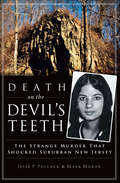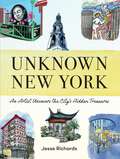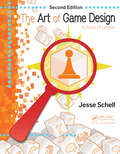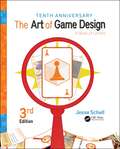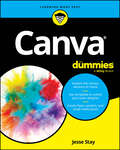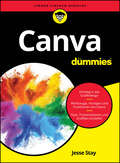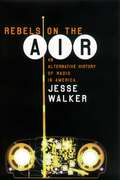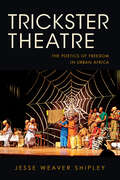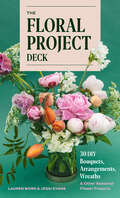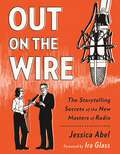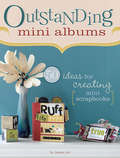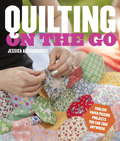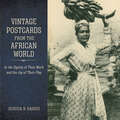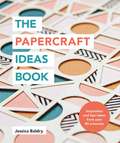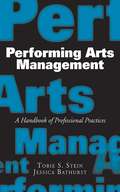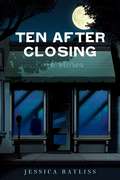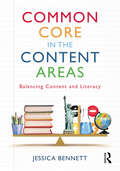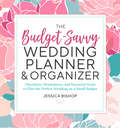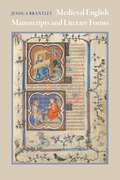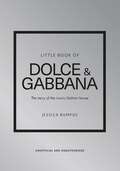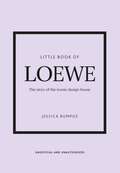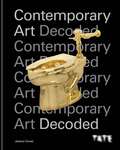- Table View
- List View
Death on the Devil's Teeth: The Strange Murder That Shocked Suburban New Jersey (True Crime Ser.)
by Mark Moran Jesse P. PollackRumors, witchcraft, and murder in this true crime account of one of New Jersey&’s most notorious cold cases—from two Weird N.J. magazine contributors. As Springfield residents decorated for Halloween in September 1972, the crime rate in the affluent New Jersey township was at its lowest in years. That mood was shattered when the body of sixteen-year-old Jeannette DePalma was discovered in the woods, allegedly surrounded by strange objects. Some feared witchcraft was to blame, while others believed a serial killer was on the loose. Rumors of a police coverup ran rampant, and the case went unsolved—along with the murders of several other young women. Including extensive interviews with DePalma&’s friends and family, new evidence, and theories about who could have committed this horrible crime, Death on the Devil&’s Teeth provides the definitive account of this shocking cold case more that remains a mystery more than four decades later.
Unknown New York: An Artist Uncovers the City's Hidden Treasures
by Jesse RichardsAn intrepid and gifted artist uncovers and illustrates more than 100 surprising, enchanting, and sometimes downright bizarre nooks and crannies that make New York such a compelling city. It&’s no surprise that New York City is the most visited destination in the U.S., and has proved itself to be an endlessly fascinating exploration ground to visitors and natives alike. Unknown New York walks readers through the vibrant, hidden, and forgotten worlds churning beneath the surface of the city. From the oldest bridge -- a footbridge described as a &“red sidewalk through the sky&” -- to a quirky and little-known Superhero Supply Store in Brooklyn to the original and abandoned Hall of Fame in the Bronx, the author takes us on a magical mystery tour through the city many people think they know. Each entry presents a brief and compelling description of a hidden park, historical site, niche shop, etc and is accompanied by a charming four-color illustration by the author. Divided into chapters titled Hidden History, Humble Parks, On the Street, Shopping Spree, Quiet Realms, Central Park, and Excusions, Jesse Richards reveals to us such extraordinary sites as the first Hall of Fame, a church where an attempted assassination took place in the 1800&’s, a part of the Bronx that resembles Capri, the many pocket parks hidden in plain sight, the less frequented corners of Central Park, unusual shops conveying surprising items for all ages, a waterfall tunnel in midtown, and so much more. Also included are curated walks to lead you to several sites in an afternoon. There&’s a Downtown River Walk, Neighborhood Parks Walk, Midtown Book-Lover&’s Walk, and a Hidden Central Park Walk.
The Art of Game Design: A Book of Lenses, Second Edition
by Jesse SchellGood game design happens when you view your game from as many perspectives as possible. Written by one of the world's top game designers, The Art of Game Design presents 100+ sets of questions, or different lenses, for viewing a game's design, encompassing diverse fields such as psychology, architecture, music, visual design, film, software enginee
The Art of Game Design: A Book of Lenses, Third Edition
by Jesse SchellThe Art of Game Design guides you through the design process step-by-step, helping you to develop new and innovative games that will be played again and again. It explains the fundamental principles of game design and demonstrates how tactics used in classic board, card and athletic games also work in top-quality video games. Good game design happens when you view your game from as many perspectives as possible, and award-winning author Jesse Schell presents over 100 sets of questions to ask yourself as you build, play and change your game until you finalise your design. This latest third edition includes examples from new VR and AR platforms as well as from modern games such as Uncharted 4 and The Last of Us, Free to Play games, hybrid games, transformational games, and more. Whatever your role in video game development an understanding of the principles of game design will make you better at what you do. For over 10 years this book has provided inspiration and guidance to budding and experienced game designers - helping to make better games faster.
Canva For Dummies
by Jesse StayThe essential guide to the popular, beginner-friendly graphic design platform Canva For Dummies is a beautiful full-color reference, covering everything you need to create dazzling visual materials in Canva Free and Pro versions. Discover all tools, templates, and features at the ready, plus utilize expert tips and tricks to improve your design and visual communication skills. Start with basic functionalities and graphic design principles, and then work your way up to more complex design tasks with ease. Canva For Dummies also covers Canva's new AI tool, Magic Studio, so you'll be up to speed on everything this cool app can do. Plus, the useful case studies and practical design projects inside are sure to ignite your creativity. Create effective social media posts, presentations, brand style guides, and everything in between, thanks to the helpful guidance in this book. Understand the Canva interface and get a primer on graphic design Explore advanced tools and techniques, including Canva's new AI tool, Magic Studio Create engaging visuals for business, social media, and beyond Utilize Canva hacks and trends to make your graphics pop This handy guide is for everyone, answering all your questions whether you're new to the platform or a current user. Rock your next design project with Canva For Dummies!
Canva für Dummies (Für Dummies)
by Jesse StaySo werden Sie zum Design-Profi Mit Canva gestalten Sie einfach und effektiv Ihre Inhalte, von Druckprodukten über Web-Banner und Social-Media-Inhalte bis hin zu Präsentationen oder Videos. Jesse Stay zeigt Ihnen mit vielen Beispielen aus der Praxis, wie Sie in Canva effektiv arbeiten und schnell gute Resultate erzielen. Angefangen bei den grundlegenden Werkzeugen und Funktionen enthält dieses Buch auch Kapitel zu den Basiskenntnissen des Grafikdesigns, der Markenbildung und effektiver visueller Kommunikation. Mit den Tipps und Tricks in diesem Buch können Sie Ihre Designträume verwirklichen. Sie erfahren Welche Designprinzipien Sie für Ihre Marke anwenden sollten Wie Sie Visitenkarten gestalten, Videos erstellen oder Designs animieren Wie die KI-gestützten Tools und Automatisierungsfunktionen von Canva Ihren Arbeitstag erleichtern
Rebels on the Air: An Alternative History of Radio in America
by Jesse WalkerExplores the alternative radio that refuses to succumb to the big business that monopolizes the airwavesBoring DJs who never shut up, and who don't even pick their own records. The same hits, over and over. A constant stream of annoying commercials. How did radio get so dull? Not by accident, contends journalist and historian Jesse Walker. For decades, government and big business have colluded to monopolize the airwaves, stamping out competition, reducing variety, and silencing dissident voices. And yet, in the face of such pressure, an alternative radio tradition has tenaciously survived. Rebels on the Air explores these overlooked chapters in American radio, revealing the legal barriers established broadcasters have erected to ensure their dominance. Using lively anecdotes drawn from firsthand interviews, Walker chronicles the story of the unsung heroes of American radio who, despite those barriers, carved out spaces for themselves in the spectrum, sometimes legally and sometimes not. Walker's engaging, meticulous account is the first comprehensive history of alternative radio in the United States. From the unlicensed amateurs who invented broadcasting to the community radio movement of the 1960s and 1970s, from the early days of FM to today's micro radio movement, Walker lays bare the hidden history of broadcasting. Above all, Rebels on the Air is the story of the pirate broadcasters who shook up radio in the 1990sand of the new sorts of radio we can expect in the next century, as the microbroadcasters crossbreed with the even newer field of Internet broadcasting.
Trickster Theatre: The Poetics of Freedom in Urban Africa (African Expressive Cultures)
by Jesse Weaver ShipleyTrickster Theatre traces the changing social significance of national theatre in Ghana from its rise as an idealistic state project from the time of independence to its reinvention in recent electronic, market-oriented genres. Jesse Weaver Shipley presents portraits of many key figures in Ghanaian theatre and examines how Akan trickster tales were adapted as the basis of a modern national theatre. This performance style tied Accra's evolving urban identity to rural origins and to Pan-African liberation politics. Contradictions emerge, however, when the ideal Ghanaian citizen is a mythic hustler who stands at the crossroads between personal desires and collective obligations. Shipley examines the interplay between on-stage action and off-stage events to show how trickster theatre shapes an evolving urban world.
The Floral Project Deck: 30 DIY Bouquets, Arrangements, Wreaths & Other Seasonal Flower Projects
by Lauren Work Jessi EvansPacked with easy-to-follow instructions, gorgeous photographs, and recipes for 30 breathtaking floral arrangements, this handy DIY deck gives you the power to create floral displays that will elevate any occasion.Design stunning floral arrangements for holiday hosting, special occasions, gifting to friends, or simply making any day a little brighter and more beautiful. This easy-to-use deck includes 30 how-to recipe cards for creating gorgeous seasonal arrangements, including: A lush harvest tablescape A welcoming holiday wreath A summer-sweet centerpiece for al fresco dining A “grateful guest” bundle to present to your host Bouquets for Valentine's Day, Mother’s Day, and more A petite booklet outlines the basics—essential tools and a flower glossary for easy reference—to get you started, and each card features a photo of a flower arrangement and step-by-step instructions. The Floral Project Deck makes it easier than ever for flower lovers to make their own gorgeous designs at home.FLOWER ARRANGING FOR ALL: These flower recipes are uncomplicated, and every card provides clear instructions and a photo, ensuring any hobbyist can easily recreate these beautiful bouquets and bundles regardless of skill level. FLORAL ART THROUGHOUT THE YEAR: A simmer pot to welcome the new year, a pastel bouquet for Mother's Day, a charming flower crown to mark the summer solstice, a colorful kale autumnal centerpiece, a festive holiday wreath: These 30 floral projects incorporate seasonal blooms, ensuring you have a gorgeous arrangement for every time of year. GIFT FOR FLOWER LOVERS: With beautiful flower photography and an eye-catching package, The Floral Project Deck makes a lovely companion for flower enthusiasts and a perfect present for any celebratory occasion.Perfect for: Anyone who likes to arrange flowers Novice or professional florists Gardeners, flower lovers, and nature enthusiasts People who buy blooms at the farmer’s market or grocery store Gift-giving for Mother's Day, birthday, housewarming, or holiday
Out on the Wire: The Storytelling Secrets of the New Masters of Radio
by Jessica AbelA Library Journal Best Book of 2015Go behind the scenes of seven of today&’s most popular narrative radio shows and podcasts, including This American Life and RadioLab, in graphic narrative. Every week, millions of devoted fans tune in to or download This American Life, The Moth, Radiolab, Planet Money, Snap Judgment, Serial, Invisibilia and other narrative radio shows. Using personal stories to breathe life into complex ideas and issues, these beloved programs help us to understand ourselves and our world a little bit better. Each has a distinct style, but every one delivers stories that are brilliantly told and produced. Out on the Wire offers an unexpected window into this new kind of storytelling—one that literally illustrates the making of a purely auditory medium. With the help of This American Life's Ira Glass, Jessica Abel, a cartoonist and devotee of narrative radio, uncovers just how radio producers construct narrative, spilling some juicy insider details. Jad Abumrad of RadioLab talks about chasing moments of awe with scientists, while Planet Money&’s Robert Smith lets us in on his slightly goofy strategy for putting interviewees at ease. And Abel reveals how mad—really mad—Ira Glass becomes when he receives edits from his colleagues. Informative and engaging, Out on the Wire demonstrates that narrative radio and podcasts are creating some of the most exciting and innovative storytelling available today.
Outstanding Mini Albums: 50 Ideas for Creating Mini Scrapbooks
by Jessica AcsThe Best Things Come in Small Packages Big memories don't require big pages. You can showcase your most important moments in irresistible, adorable mini scrapbooks! Outstanding Mini Albumsis filled with inspiration, ideas and instructions for creating mini scrapbooks of all kinds, from cleverly embellished store-bought albums to books made completely from scratch. Fifty fabulous illustrated projects show you how mini albums are perfect for scrapping lots of photos quickly, displaying your memories around the house, and giving as one-of-a-kind gifts. Step by step, you'll learn to: Make pre-made albums all your own with fun themes and original embellishments. Reinvent everyday items like coffee cups and CDs as pages for handmade mini books. Master new techniques, like crafting faux epoxy letters and homemade buttons. Give your creativity a mini makeover! When a scrapbook page seems too small but a whole album seems too big,Outstanding Mini Albumswill help you get it just right.
Quilting on the Go
by Jessica AlexandrakisBreak Free from Your Sewing Machine Imagine being able to quilt on vacation, at the beach, or virtually anywhere else you find yourself. Jessica Alexandrakis has traveled the world with her on-to-go sewing kit and small stash of fabric, creating strikingly modern patchwork along the way. Now she shares everything she's learned about this addictive, beginner-friendly technique. * Sewing kit essentials that you can slip in your bag so you'll always be ready to stitch * Color theory and stash organization tips for dramatic effects or scrap-happy results * Creative patterns to combine hexagons, half-hexagons, diamonds, stars, squares, and triangles * 10 step-by-step projects, including the hand-pieced Laptop Bag, Tanuki Stripe Throw, Falling Stars Baby Quilt, and Jessica's signature Travel Quilt * 10 customizable quilt patterns with 40 vibrant color palette suggestions Whether your style is classic or modern, Jessica offers a range of stunning projects, from small home accessories to full-size quilts, for all skill levels. So leave the sewing machine at home. Take your quilt to go.
Vintage Postcards from the African World: In the Dignity of Their Work and the Joy of Their Play (Atlantic Migrations and the African Diaspora)
by Jessica B. HarrisFor over forty years, professor and culinary historian Jessica B. Harris has collected postcards depicting Africans and their descendants in the American diaspora. They are presented for the first time in this exquisite volume. Vintage Postcards from the African World: In the Dignity of Their Work and the Joy of Their Play brings together more than 150 images, providing a visual document of more than a century of work in agricultural and culinary pursuits and joy in entertainments, parades, and celebrations. Organized by geography—Africa, the Caribbean, and the United States—as well as by the types of scenes depicted—the farm, the garden, and the sea; the marketplace; the vendors and the cooks; leisure, entertainments, and festivities—the images capture the dignity of the labors of everyday life and the pride of festive occasions. Superb and rare images demonstrate everything from how Africans and their descendants dressed to what tools they used to how their entertainments provided relief from toil. Three essays accompany the postcards, one of which details Harris’s collection and the collecting process. A second presents suggestions on how to interpret the cards. A final essay gives brief information on the history of postcards and postcard dating and its increasing use and value to scholars.
The Papercraft Ideas Book
by Jessica BaldryBursting with ideas for papercraft subjects, methods and styles, this book is a visual feast and source of inspiration for artists of all abilities looking to expand their papercraft skills. Discover more than 80 stunning papercraft artworks by contemporary, international artists, and reinvigorate your own practice with the help of their diverse and innovative approaches. Techniques include 3D collage, paper marbling and paper quilling, as well as stitching onto paper, paper embossing and traditional papercutting. Through countless tips and guidance, you'll be empowered to work with paper, expand your creativity and create art that is original and exciting.
The Papercraft Ideas Book: Inspiration And Tips Taken From Over 80 Artworks
by Jessica BaldryBursting with ideas for papercraft subjects, methods and styles, this book is a visual feast and source of inspiration for artists of all abilities looking to expand their papercraft skills. Discover more than 80 stunning papercraft artworks by contemporary, international artists, and reinvigorate your own practice with the help of their diverse and innovative approaches. Techniques include 3D collage, paper marbling and paper quilling, as well as stitching onto paper, paper embossing and traditional papercutting. Through countless tips and guidance, you'll be empowered to work with paper, expand your creativity and create art that is original and exciting.
Performing Arts Management: A Handbook of Professional Practices
by Tobie S. Stein Jessica BathurstDo you know what it takes to manage a performing arts organization today? In this comprehensive volume, more than 100 managers of top nonprofit and commercial venues share their winning strategies.* Financial management, building a funding base, labor relations, much more* Explores the realities of running a performing arts organization todayFrom theater to classical music, from opera to dance, every type of organization is included, with information on how each one is structured, key managerial figures, its best-practices for financial management, how it handles labor relations, and more. Kennedy Center, the Brooklyn Academy of Music, Lincoln Center, the Mark Morris Dance Company, the New Victory Theater, the Roundabout Theater, the Guthrie Theater, Steppenwolf Theater Company, and many other top groups are represented. Learn to manage a performing arts group successfully in today's rapidly changing cultural environment with Performing Arts Management.
Ten After Closing
by Jessica Bayliss10PM: Closing time at Café Flores. The door should be locked, but it isn't, Scott Bradley and Winsome Sommervil are about to become hostages. <p><p> TEN MINUTES BEFORE CLOSING: Scott's girlfriend breaks up with him in the café's basement storeroom because he's late picking her up for the big end-of-the-year party. Now he can't go to the party, but he can't go home, either―not knowing his dad will still be in a drunken rage. Meanwhile, Winny wanted one night to let loose, away from her mother's crushing expectations. Instead, she's stranded at the café after her best friend ditches her in a misguided attempt at matchmaking. <p> TEN MINUTES AFTER CLOSING: The first gunshot is fired. Someone's dead. And if Winny, Scott, and the rest of the hostages don't come up with a plan soon, they may not live to see morning. <p> Told from both Winny and Scott's perspectives, and alternating between the events leading up to and following the hold-up, Ten After Closing is an explosive story of teens wrestling with their own challenges, thrown into circumstances that will test their very limits.
Common Core in the Content Areas: Balancing Content and Literacy
by Jessica BennettThe Common Core is requiring literacy across the curriculum, but what does that mean for teachers of subjects like math, science, and social studies who have a lot of content to cover? In this essential book, author Jessica Bennett reassures you that you don’t have to abandon all of your great content lessons and start from scratch. Instead, you can reflect on what you‘re already doing well and make adjustments and enhancements as necessary. Bennett starts with a clear breakdown of the Common Core ELA Social Studies/History and Science and Technical Subjects Standards for Grades 7-12 and what they actually look like. She provides a variety of practical strategies and scaffolds that you can use immediately to enhance your curriculum and meet the standards. You will learn how to... Incorporate a wider variey of texts into your currciulum Teach students to use each text with purpose, whether it is for close reading, support, argumentation, or research Assign meaningful group work and projects without feeling that they have to take up your whole curriculum Help students navigate their textbooks more effectively and read for information Use the Common Core to meet the needs of diverse learners Implement the four As strategy in which students absorb content, analyze information, argue reasons, and apply knowledge Use writing tasks to strengthen student comprehension of content Teach various forms of writing and the importance of text citations And more! Throughout the book, you’ll find tools such as unit planning sheets, daily lesson plan sheets, classroom handouts, sentence starters, and more. If you teach a content area, this must-have resource will help you meet the Common Core with ease!
The Budget-Savvy Wedding Planner & Organizer: Checklists, Worksheets, and Essential Tools to Plan the Perfect Wedding on a Small Budget
by Jessica BishopBring your big day to life without breaking the bank—from Jessica Bishop, budget wedding expert and founder of The Budget-Savvy Bride!Congratulations! Getting married is a thrilling time and a major milestone—but you might be overwhelmed at how much there is to do and how much it's going to cost. Here's the secret: You don't need to spend a year's salary on your wedding day for it to be unique and memorable. Author Jessica Bishop shows you how with this complete wedding planner book!Stay organized and on track—This wedding planner is perfect for couples who want to plan a unique and memorable wedding on a budget. It includes creative ideas and inspiration for all aspects of your wedding, from the ceremony to the reception.Your ultimate wedding book, planner, and organizer—Worksheets, lists, and tips from an expert wedding planner to help you prioritize the things you want most and create a wedding that's affordable, stress-free, and totally yours.Flexible budget advice—Learn how to save money and avoid common industry traps, so you can throw a beautiful wedding whether your budget is $1,500 or $50,000.The ceremony and beyond—Find chapters that cover every aspect of your wedding, from your initial vision, to the venue, photography, food, music, and even the honeymoon.Pick up The Budget-Savvy Wedding Planner & Organizer today and start planning an affordable wedding you'll never forget.
Medieval English Manuscripts and Literary Forms (Material Texts)
by Jessica BrantleyIn Medieval English Manuscripts and Literary Forms, Jessica Brantley offers an innovative introduction to manuscript culture that uses the artifacts themselves to open some of the most vital theoretical questions in medieval literary studies. With nearly 200 illustrations, many of them in color, the book offers both a broad survey of the physical forms and cultural histories of manuscripts and a dozen case studies of particularly significant literary witnesses, including the Beowulf manuscript, the St. Albans Psalter, the Ellesmere manuscript of the Canterbury Tales, and The Book of Margery Kempe. Practical discussions of parchment, scripts, decoration, illustration, and bindings mix with consideration of such conceptual categories as ownership, authorship, language, miscellaneity, geography, writing, editing, mediation, illustration, and performance—as well as of the status of the literary itself.Each case study includes an essay orienting the reader to particularly productive categories of analysis and a selected bibliography for further research. Because a high-quality digital surrogate exists for each of the selected manuscripts, fully and freely available online, readers can gain access to the artifacts in their entirety, enabling further individual exploration and facilitating the book’s classroom use. Medieval English Manuscripts and Literary Forms aims to inspire a broad group of readers with some of the excitement of literary manuscript studies in the twenty-first century. The interpretative frameworks surrounding each object will assist everyone in thinking through the implications of manuscript culture more generally, not only for the deeper study of the literature of the Middle Ages, but also for a better understanding of book cultures of any era, including our own.
Little Book of Dolce & Gabbana: The story of the iconic fashion house (Little Books of Fashion)
by Jessica BumpusElaborate, luxurious and powerful, the Dolce & Gabbana look has always exuded decadent sensuality.With tailoring and corsets, baroque prints and innovative silhouettes, the fashion house's Italian roots sing through their distinctive ensembles in lace, leopard print and florals. Founded by designer duo Domenico Dolce and Stefano Gabbana in 1985, the brand's opulent pieces have been worn by everyone from Naomi Campbell to Jennifer Lopez.Through photographs of over 100 stunning looks alongside captivating expert text, Little Book of Dolce & Gabbanatells the story of one of the most glamorous fashion houses in the world.
Little Book of Dolce & Gabbana: The story of the iconic fashion house (Little Books of Fashion)
by Jessica BumpusElaborate, luxurious and powerful, the Dolce & Gabbana look has always exuded decadent sensuality.With tailoring and corsets, baroque prints and innovative silhouettes, the fashion house's Italian roots sing through their distinctive ensembles in lace, leopard print and florals. Founded by designer duo Domenico Dolce and Stefano Gabbana in 1985, the brand's opulent pieces have been worn by everyone from Naomi Campbell to Jennifer Lopez.Through photographs of over 100 stunning looks alongside captivating expert text, Little Book of Dolce & Gabbanatells the story of one of the most glamorous fashion houses in the world.
Little Book of Loewe (Little Books of Fashion)
by Jessica BumpusFrom avant-garde accessories to directional red-carpet glamour, Loewe is the fashion house of the moment.Modern twists bring an unbridled joy to its cult items, from surreal balloon heels to the coveted Puzzle bag, with every design underpinned by craftsmanship. Loewe's fashion-forward looks are worn by everyone from Anna Wintour to Zendaya while visionary creative director Jonathan Anderson continues the heritage house's legacy of reinvention. With over 100 stunning photographs accompanied by engaging text, Little Book of Loewe uncovers the story of an iconic brand that continues to redefine the fashion landscape.
Little Book of Loewe (Little Books of Fashion)
by Jessica BumpusFrom avant-garde accessories to directional red-carpet glamour, Loewe is the fashion house of the moment.Modern twists bring an unbridled joy to its cult items, from surreal balloon heels to the coveted Puzzle bag, with every design underpinned by craftsmanship. Loewe's fashion-forward looks are worn by everyone from Anna Wintour to Zendaya while visionary creative director Jonathan Anderson continues the heritage house's legacy of reinvention. With over 100 stunning photographs accompanied by engaging text, Little Book of Loewe uncovers the story of an iconic brand that continues to redefine the fashion landscape.
Tate: Contemporary Art Decoded
by Jessica CerasiWhat is contemporary art, and how did art come to be what it is today? How can we understand what a work of art means; and can't just about anything be called art these days?Contemporary Art Decoded takes ten key questions about contemporary art and uses them to what you're looking at, how it works, and why it matters. Steering clear of jargon, this book digs deep into the core ideas and concepts behind the art. It features some work you'll recognise, and some you won't, from some of the most exciting artists working today, such as Olafur Eliasson, Anish Kapoor, Yayoi Kusama and Zanele Muholi.This book is guaranteed to make your next trip to a gallery more rewarding.Chapters include:- What is contemporary art?- Where did it come from?- Where do you draw the line?- Does it matter who makes it?- Does it have to mean something?- Can anything be art?- What about art for art's sake? - Has it all been done before?- Does it have to be so serious?- What's next?
